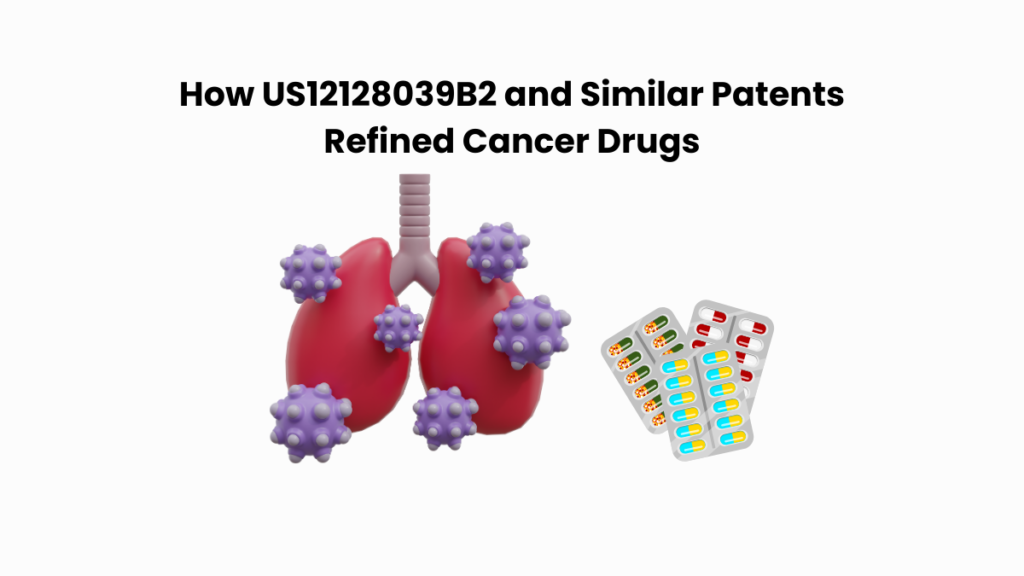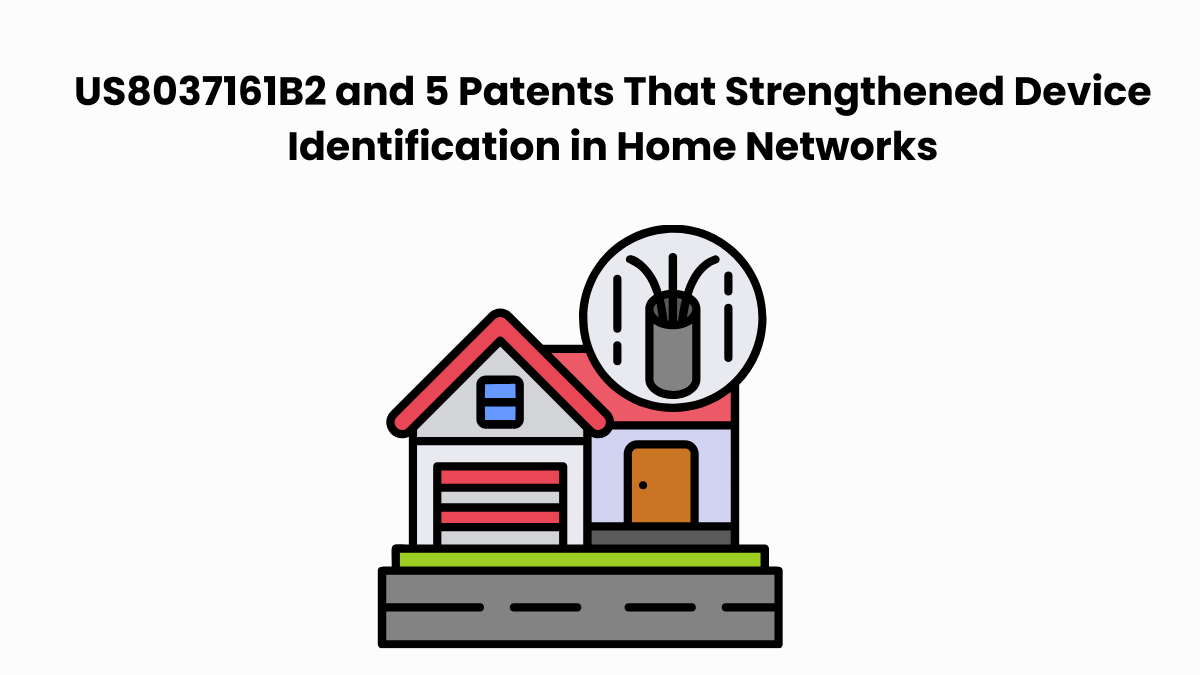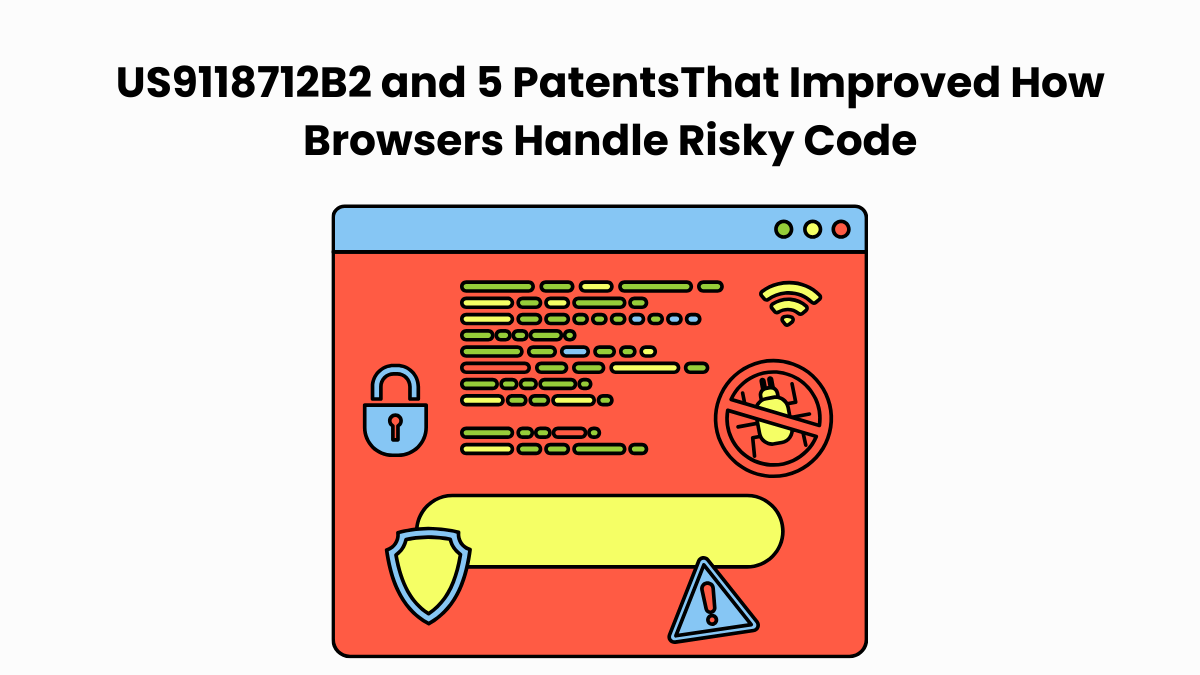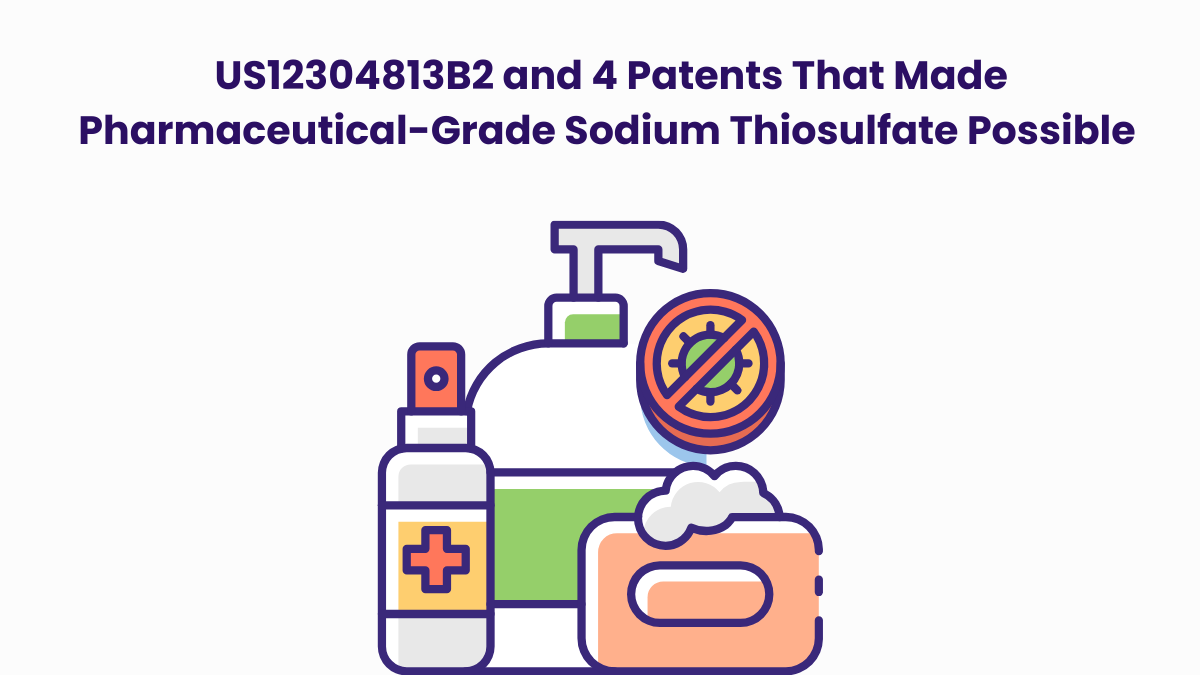Developing cancer drugs isn’t just about finding the right molecule; it’s also about making it cleanly and consistently. Quinoline compounds, widely used in targeted therapies, help block protein kinases that drive tumor growth. But older synthesis methods often left behind impurities that could affect stability and performance.
US12128039B2, filed by Exelixis Inc., describes better methods for making quinoline compounds. It improves crystallization, reduces unwanted byproducts, and ensures the stability of oral forms such as tablets and capsules.
The patent is now part of a lawsuit between assignee Exelixis Inc. against MSN Laboratories and others.
But our interest lies in the bigger challenge: how cancer drugs are refined to be safer and more reliable?
To place this invention in context, we used the Global Patent Search (GPS) tool to examine similar patents that connect to this landscape. Some disclose entirely new kinase-inhibiting compounds, while others detail alternative synthesis and formulation methods.
Together, the filings show how researchers are pushing both discovery and process innovation to make kinase-targeted cancer drugs safer, purer, and more effective. But before we dive in, let’s understand the subject patent first.
Breaking Down Patent US12128039B2
Patent US12128039B2 describes improved methods for making quinoline-based compounds used in drug-based treatments for cancer. These compounds help block specific enzymes, known as protein kinases, that are often overactive in cancer cells.
The patent also outlines methods for reducing impurities during production and creating stable oral drug forms, such as tablets and capsules. The goal is to ensure that the final drug product is clean, effective, and consistent, ready for safe use in treating diseases driven by kinase activity.
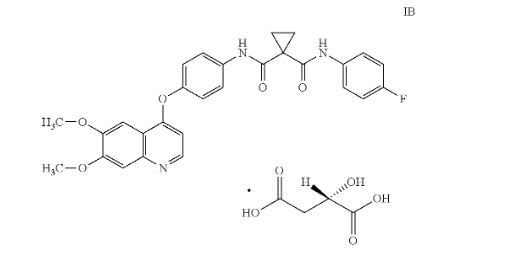
Source: Google Patents
Key Features Of This Patent Are
1. Improved Synthesis of Quinoline Compounds
Describes processes to make quinoline derivatives with better control and fewer byproducts.
2. Flexible Substitutions In The Molecule
Allows different halogen atoms (like Cl, Br, or F) at specific positions to create compound variants.
3. Protein Kinase Modulation
The compounds target key kinases like c-Met, VEGFR, KDR, c-Kit, Axl, and Flt-3.
4. Controlled Crystallization Process
Uses a mix of solvents, acids, and temperature control to yield high-purity solid forms.
5. Reduced Process Contaminants
Ensures that final compounds contain less than 100 ppm of unwanted byproducts, such as 6,7-dimethoxyquinoline-4-ol.
6. Tablet And Capsule Formulations
Lists detailed compositions using ingredients like microcrystalline cellulose, lactose, and magnesium stearate.
7. Polymorph Control (N-1 and N-2 Forms)
Includes methods to selectively produce specific crystalline forms of the compound for better stability.
8. Stable Under Stress Conditions
Capsule compositions show minimal degradation even under high heat and humidity.
These innovations make US12128039B2 a strong example of process chemistry applied to drug development. It blends molecular precision with manufacturing efficiency to improve pharmaceutical outcomes.
Related Read: See how US10828310B2 tackles stroke and heart attack prevention through dual-drug therapy, echoing broader innovations in combination drug delivery systems.
Similar Patents To US12128039B2
To explore the scientific context of US12128039B2, we used the Global Patent Search tool to uncover similar patents. These references focus on kinase inhibition and pharmaceutical compositions designed to interfere with cancer-related signaling pathways. Each takes a distinct approach to targeting kinases such as c-Met, VEGFR, or related proteins involved in cell growth and proliferation. Let’s take a look.
1. US2005288290A1
This US patent, US2005288290A1, published in 2005, discloses compounds designed to block a cancer-related enzyme called c-Met. This enzyme helps tumors grow, spread, and build new blood vessels. The patent describes small molecules that can stop this enzyme from working effectively.
These compounds are intended to treat cancer and other diseases by disrupting signals that cells use to grow and survive. They can be taken in tablet or capsule form and may be used alongside common chemotherapy drugs like cisplatin or taxanes.
Below, we have added snapshots from the GPS tool displaying the relevant sections and overlap from similar patents.
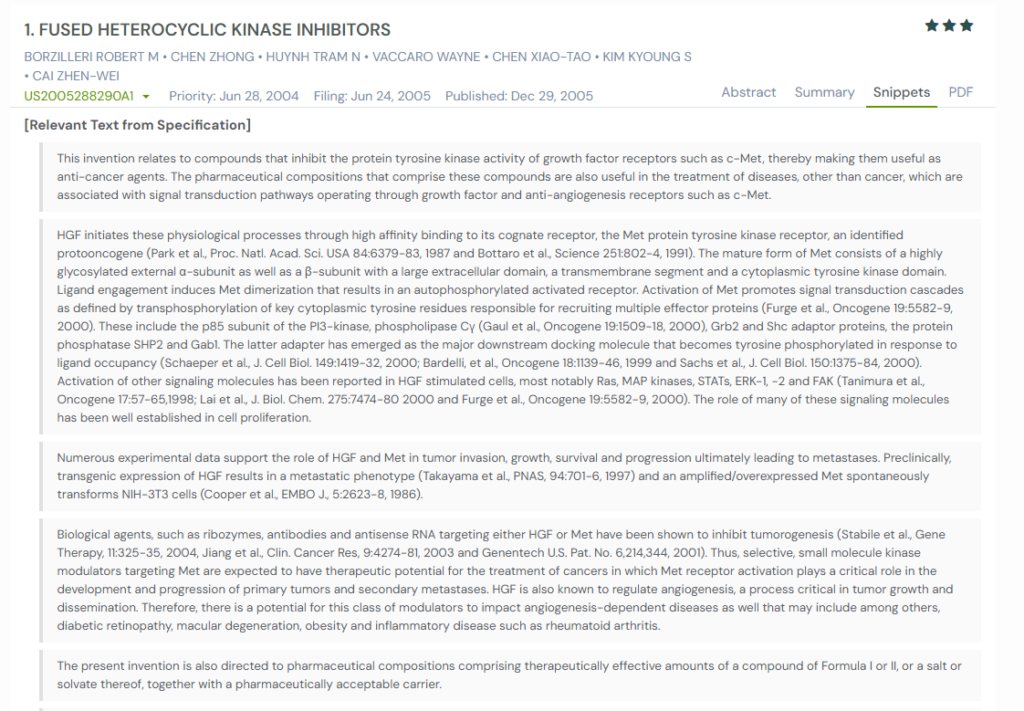
What This Patent Introduces To The Landscape
- Small molecules that block the c-Met receptor tyrosine kinase
- Ability to slow or stop cell growth, tumor spread, and new blood vessel formation
- Oral drug forms like tablets and capsules
- Applications beyond cancer, including autoimmune and neurodegenerative diseases
- Potential for use with existing chemotherapy agents
How It Connects To US12128039B2
- Both focus on stopping cancer by targeting protein kinases
- US2005288290A1 introduces new drug compounds, while US12128039B2 improves how they are made
- Each supports oral cancer treatments with reliable quality
- Together, they represent two sides of innovation: drug discovery and process optimization
Why This Matters
This patent helps explain how blocking enzymes like c-Met can fight cancer. While US2005288290A1 offers new treatment compounds, US12128039B2 ensures they can be manufactured cleanly and consistently.
Related Read: See how US12122789B2 stabilizes risdiplam in solid form, aligning with patents like US12128039B2 that refine synthesis for more reliable medicines.
2. US2007066610A1
This US patent, US2007066610A1, published in 2007, describes a new class of compounds called acylhydrazones that act as kinase inhibitors. Specifically, these compounds target c-Met, a key enzyme that regulates the growth, movement, and spread of cancer cells.
The patent explains that when c-Met goes out of control, due to mutations or overactivity, it can drive many types of cancer. These include solid tumors like lung, liver, breast, and prostate cancer, as well as blood cancers like leukemia and lymphoma.
The compounds in this patent are designed to stop c-Met from working, slow down tumor growth, and block the formation of new blood vessels (angiogenesis).
What This Patent Introduces To The Landscape
- Acylhydrazone compounds that inhibit c-Met kinase activity
- Potential treatments for a wide range of cancers and cell proliferation disorders
- Methods to make and test these compounds using NMR and mass spectrometry
- Drug formulations suitable for both oral and targeted delivery
- Use in combination therapies with chemotherapy, gene therapy, or immunotherapy
- Potential cardiovascular applications, including restoring blood vessel health via stent delivery
- Techniques to resolve compound isomers for better drug purity and activity
- Screening methods like fluorescence polarization and DELFIA assays for potency evaluation
- Use of monoclonal antibodies to help direct the drug to tumors more precisely
How It Connects To US12128039B2
- Both patents focus on c-Met inhibition, a crucial target in cancer treatment
- US2007066610A1 introduces new compounds, while US12128039B2 ensures their clean production
- Each supports therapies that are stable, precise, and ready for pharmaceutical use
- Together, they highlight how better compound design and manufacturing work hand-in-hand
Why This Matters
This patent shows how targeting enzymes like c-Met can treat cancer and other serious diseases. While US2007066610A1 offers new therapeutic compounds, US12128039B2 helps make them safer and cleaner to produce. Both patents push forward the development of next-generation cancer treatments.
You can also explore how purity-focused processes are evolving through patents like US12304813B2, which outlines a modern approach to creating pharmaceutical-grade sodium thiosulfate.
3. US2002091130A1
This US patent, US2002091130A1, published in 2002, discloses nitrogen-containing heterocyclic compounds and the processes used to create them. These compounds are designed to inhibit kinase enzymes, particularly those involved in cell growth and survival.
Kinases are proteins that help regulate how cells grow, divide, and respond to signals. When these kinases are too active, they can lead to diseases such as cancer, inflammation, and cardiovascular disorders. This patent focuses on stopping that overactivity, especially in receptor tyrosine kinases.

What This Patent Introduces To The Landscape
- Nitrogen-containing heterocyclic compounds that inhibit kinase phosphorylation
- Inhibition of key kinases: PDGF, VEGFR, FGF, EGFR, Flt3, CSF-1R, and non-receptor kinases like src, abl, MEK, MAPK, CDKs
- Application in treating cancer, cardiovascular disease, inflammation, and fibrosis
- Processes for making pharmaceutically acceptable salts, isomers, hydrates, and prodrugs
- Development of prodrug derivatives that become active in the body after metabolism
- Specific synthetic routes using well-known organic chemistry techniques
- Use of protecting groups and purification methods for clean, targeted synthesis
- Compounds with IC50 values below 1 μM, indicating strong potency
- Possibility of targeted delivery using polymers, antibodies, or controlled-release systems
- Formulations suitable for various routes of administration, including oral, injectable, and implantable delivery
How It Connects To US12128039B2
- Both patents focus on producing highly active kinase inhibitors
- US2002091130A1 offers novel heterocyclic structures, while US12128039B2 ensures their clean and stable synthesis
- The technologies can work together to enable safe and efficient production of new cancer treatments
- US12128039B2 supports purification and form optimization for compounds like those disclosed here
Why This Matters
This patent brings a wide class of kinase inhibitors into focus, offering a foundation for treating multiple serious diseases. Combined with the clean production methods of US12128039B2, it helps accelerate the path from lab discovery to clinical use.
If you’re tracking recent litigation around formulation-based pharmaceutical patents, our analysis of Allergan’s US12097187B2 case offers a useful comparison point.
4. US2002147214A1
This US patent, US2002147214A1, published in 2002, discloses heterocyclic compounds designed to block protein tyrosine kinases. These enzymes help control how cells grow, divide, and communicate. When they malfunction, they can cause diseases like cancer, psoriasis, and autoimmune disorders.
This patent focuses on quinoline and quinazoline derivatives that stop overactive kinases.. These compounds aim to reduce unwanted cell growth in tumors and other hyperproliferative conditions.

What This Patent Introduces To The Landscape
- Quinoline and quinazoline derivatives that inhibit receptor tyrosine kinases
- Strong activity against EGFR, c-erbB-2, c-Met, and other disease-related kinases
- Specific compound modifications for target selectivity and potency
- Clear link between kinase inhibition and tumor suppression
- Coverage of multiple substituent groups and heterocyclic ring systems
- Strategies to inhibit angiogenesis, inflammation, and hyperactive immune responses
How It Connects To US12128039B2
- Both patents focus on molecules that inhibit kinase signaling, which is critical in treating cancer.
- US2002147214A1 offers therapeutic compounds, while US12128039B2 enhances their manufacturing process.
- The quinoline core structure links both inventions in mechanism and application.
- US12128039B2 improves the purity and formulation of drugs like those disclosed here.
Why This Matters
This patent highlights how blocking overactive kinases can stop disease progression. Its focus on quinoline-based kinase inhibitors directly supports the need for clean, scalable production methods. This is exactly what US12128039B2 addresses.
5. US5908930A
This US patent, US5908930A, published in 1999, discloses a class of compounds called pyrimido[4,5-b]quinolines. These are potent tyrosine kinase inhibitors designed to block enzymes involved in harmful cell growth. The patent also details their pharmaceutical use and chemical preparation.
These inhibitors are developed for diseases driven by abnormal kinase activity, including cancer, atherosclerosis, and disorders like diabetic retinopathy.
What This Patent Introduces To The Landscape
- A new family of pyrimidoquinoline compounds that inhibit tyrosine kinases
- Applications for cancer, antiangiogenesis, and atherosclerosis treatment
- Laboratory methods for testing kinase inhibition using pp60src assays
- Detailed multistep chemical synthesis with defined reagents and conditions
- Use of solvents like DMF and DMSO for high-temperature reaction support
How It Connects To US12128039B2
- Both focus on technologies targeting tyrosine kinase pathways
- US5908930A discloses the drug compounds; US12128039B2 supports how they’re made
- Each contributes to the goal of improving cancer therapy through targeted kinase inhibition
- US12128039B2 enhances the efficiency and purity of manufacturing such compounds
Why This Matters
This patent adds a valuable approach to developing tyrosine kinase inhibitors. US12128039B2 complements it by making the manufacturing of such inhibitors safer and cleaner for pharmaceutical use.
If you are interested in gaining knowledge about how intravascular clot removal systems work, our patent analysis of US11890180B2 can help you.
Related reading: You may also find value in the analysis of US12144810B1 and similar patents, which provide deeper insight into improving the delivery and performance of specific medications.
How to Find Related Patents Using Global Patent Search

Making cancer medication better is not only about discovering new compounds. It is also about producing them safely, cleanly, and in ways that ensure patients get consistent results.
The Global Patent Search tool helps reveal how different patents contribute to this bigger goal, from refining quinoline synthesis to improving drug purity and stability.
Here’s how to use the tool effectively:
1. Start with the patent number: Enter US12128039B2 into GPS tool. You can also try keywords like “quinoline synthesis,” “kinase inhibitor,” or “process impurities.” This helps narrow your search to patents with similar technical goals.
2. Explore relevant snippets: Instead of full claims, GPS highlights key technical phrases. These snippets point to process innovations, like ways to limit impurities, control stereochemistry, or improve yield.
3. Identify similar process strategies: Use the tool to uncover patents solving related synthesis problems, like avoiding hazardous reagents, improving salt formation, or refining intermediate steps.
4. Compare technical approaches side by side: Rather than matching exact claims, GPS lets you see how different inventions handle purification or reaction conditions in similar compound classes.
5. Expand across therapeutic areas: Because quinoline derivatives and kinase inhibitors appear in oncology, inflammation, and more, GPS helps you track cross-domain ideas and stay ahead of formulation and process trends.
Whether you are scaling up production or filing new patents, Global Patent Search makes it easier to uncover relevant strategies and strengthen your innovation pipeline. Try the tool today!
Want to sharpen your search workflow even more? Check out our guide on how to do a patent search faster using GPS for practical tips and shortcuts.
Disclaimer: The information provided in this article is for informational purposes only and should not be considered legal advice. The related patent references mentioned are preliminary results from the Global Patent Search tool and do not guarantee legal significance. For a comprehensive related patent analysis, we recommend conducting a detailed search using GPS or consulting a patent attorney.

